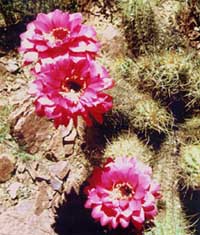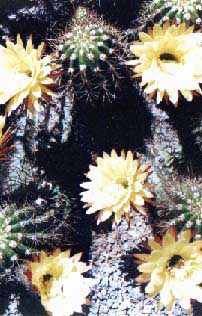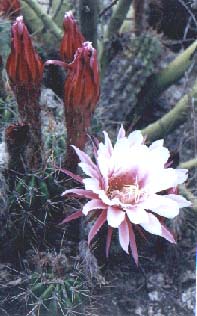Trichocereus
Pseudocandicans |
|||
.3 years old cultivated plant |
|||
Trichocereus
Pseudocandicans |
|||
.3 years old cultivated plant |
|||
| In the Sierra Famatina the Trichocereus kwown as
"pseudocandicans" show huge flowers with so
many different colours that I have thought to make a
present to all Cactus Lovers, but mainly to Trichocereus
Lovers in publishing a web-page about this not very much
known species . The photos 1,2,3,4,6,7,10,11,12 are by
Andreas Wessner (Germany), 5,9 by Willy Smith (Argentina),
8 by Franz Strigl (Austria). The following article is
taken from the Hybriden-Journal n.1/2000 of the German Arbeitsgruppe Echinopsis-Hybriden . |
 |
||
| .......................................................Click on the photos or on the map to enlarge
them. Argentinean Flowering Fireworks |
 1 1 |
||
| ..As a contrast, the white nocturnal flowers of Trichocereus candicans where described as early as 1834 by Salm-Dyck as Cereus candicans (Gillies). The name candicans which means white blossoming originates with the Scottish Physician John Gillies who traveled in the Argentinian Andes and found this species in the area near Mendoza. The nomenclature of this species has had a very busy life. While Schumann kept the species with Cereus, it could in the meantime be found near Echinocereus by Rumpler, under Echinocactus by Pfeiffer, in the genus Trichocereus by Britton and Rose, and under Echinopsis by Weber , where it is again to be found according to the latest status of the systematics. Echinopsis candicans as the species will be called is widely distributed in the provinces | 2 |
||
| Mendoza, Cordoba, San Juan, La Roja and Catamarca and is highly variable as far as the body, spines and flowers are concerned. Schumann who made the first description of the flower indicates a flower lenght of 15cm (6in.) . In contrast I have experienced a flower lenght and diameter of 25cm (10in.) in my own collection. Echinopsis candicans is closely related to Echinopsis huascha (Web.)Friedr,Rowley and its many coloured variations, and probably leads to local natural hybrids, the earlier mentionated Trichocereus pseudocandicans or Echinopsis pseudocandicans the province La Rioja . Dr. Carlos Cult Hosseus mention a red blooming T.candicans in his book "Notas sobre Cactaceas Argentinas, Cordoba 1939". | 3  |
||
| He apparently didn't see the flower himself, as he quotes a journal for Physicians "Ann. Asoc. Quicica Argentina" in which a certain Prof. Juan T. Lewis and Dr. L.Reti sighted and reported about this unusual flower near Chilecito a la Cuesta de Miranda in the province La Rioja in January 1933. Exactly 10 years later E.Vatter of Argentina reports in the Scweitzer Sukkulentkunde III concerning Trichocereus candicans which blossomed in wonderfull blod-red, lemon-yellow, and pink- violet colours. He also found his many colored Trichocereus Vatter 15 plants in the same habitat that, according to Rausch, are nothing other than huascha forms and it is inevitable that there would be natural hybrids with trichocereus candicans.Vatter reports further : "One must see these flowers oneself, in order to delight in the colorful disply and in this |  4 4 |
||
| treasure." These cereus bushes are rare however, and one can only distinguish them from normal white blossoming plants while they are in flower. The original plant material was sent by Vatter to the City Succulent Collection in Zurich. At the beginning of the 70's Mr. Krainz answered my inquiry about what had happened to these cacty by informing me that the Vatter's plants had been frozen in a cold frame after a breakdown of the heating system. But that was not really bad as they "ONLY" been hybrids ! This of course did not deter my love of these unique plants and I was therefore grately pleased when Kiesling and Fechser sent me supposedly red flowering |  5 5 |
||
| Trichocereus candicans
plant from Argentina in the early 70's which houever
subsequently all showed yellow flowers. My enthusiasm for this group of plants went so far that I flew to Argentina with a cactus friend to see these plants so to speak "in the flesh" . We did see thousands of large plants groups with up to 6 meters diameter, but only with white flowers. We were not to have the privilege of seeing the colorful flowering fireworks. I can only report of one exception. We sighted a red-flowering pseudocandicans in a house garden in a small town some 100 km south of Aimogasta. Even for the inhabitants |
|||
| these colorful pseudocandicans are something special and rare, since they stand out in the sea of white blossoms. One of the reasons that these Echinopsis pseudocandicans are not to be seen in hour collections is because of their steams which are approx. 10cm (4 in.) thick and up to 1 meter (39 in.) long , building many headed groups which take up a lot of space. Individual steams of 20-30cm (8-12 in.) hight can already produce flowers in a sunny location. For the sake of beeing complete it should be mentioned that Backeberg defined the species pseudocandicans and placed it in the genus Helianthocereus. Before that however he described the |  7 7 |
||
| species as Helianthocereus pecheretianus. A red flowering form was described by him as Trichocereus candicans v. roseiflorus which was later changed in Helianthocereus pseudocandicans v. roseiflorus. Ritter references the Backeberg Helianthocereus pseudocandicans as a synonym of candicans form rubriflorus. All of this nomenclatural ballast and the corrisponding confusion have not helped this species. But when one try to describe natural hybrids, perhaps it is inevitable. Robert Graser of Nuremberg (Germany) who it can be proved, crossed T. candicans with Aporocactus flagelliformis, Echinopsis grandiflora, Echinopsis kermesina, Echinopsis oxigona, Lobivia grandiflora, Lobivia huascha,Trichocereus purpureopilosus, Trichocereus schickendantzii and Vatter 15 yellow over 50 years ago, also created a large number of cultured hybrids. When one | |||
| experiences these flowers with their finely differentiated color nuances, one sees that they are not in any way inferior to the natural hybrids. In Succulenta from 1996 Mr F. Van der Broeck reported about his trip trough Argentina and is compleately excited about this Echinopsis pseudocandicans and described it as a color festival in Sierra Famatina.Due to the locally very rare existance of this Echinopsis pseudocandicans many flower colors have only been seen on one plant and because of the large size of of the plant its reproduction and distribution in the collections of enthusiasts will be limited . |  9 9 |
||